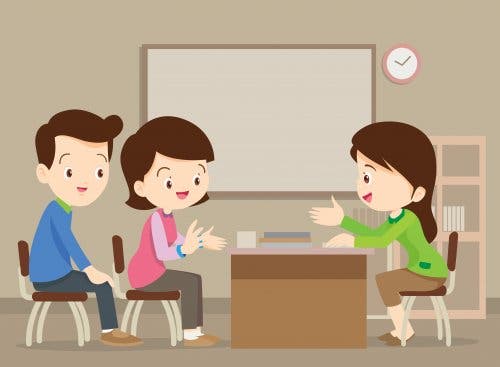The Importance of Family-School Communication

For family-school communication to be effective, it must be continuous, bidirectional, meaningful, and focused on the student’s learning. Communication is the foundation of any solid educational relationship.
It’s proven that, when parents and school staff communicate effectively, positive relationships develop. Furthermore, this helps solve problems more easily and allows students to make more progress.
Although schools routinely deliver information in the form of newsletters, brochures, manuals, and their websites, this doesn’t always provide an easy way to communicate or get families to respond on a regular basis.
In fact, even PTA (parent-teacher association) meetings are often considered by school leaders as a way to get a message across to families, not bi-directional. The most effective way to build a truly useful relationship is to create regular opportunities for open and honest dialogue.
Good family-school communication allows parents to establish relationships with their child’s teacher. Thus, parents can feel comfortable being able to talk to their child’s teacher about any concerns they may have. Also, teachers can explain to parents what’s going on in their classroom at any given time.
In addition, when teachers and parents communicate on a regular basis, teachers can give parents more specific information about school events and volunteer opportunities that are needed in the classroom. When parents become aware of these opportunities, they’re often excited to be able to more actively participate in their child’s education.

Family-school communication: Sharing information
All families should feel that their child’s school keeps them informed on important issues and that it’s easy to communicate with teachers, the principal, and other staff members. Here are the key questions to answer to see how communication is:
- Firstly, does the school offer different ways to communicate every day?
- Also, does the school or PTA survey families at least once a year to know what they think?
- Are the school’s principal and administrative staff easily accessible to any parent?
- Likewise, does the school and PTA make it easy for parents and families to connect and communicate with each other?
- Finally, is the school’s website useful and easily accessible to families?
What can you do to improve family-school communication?
First step
To begin, a team would need to be created to identify the school’s strengths and needs, both in practice and in theory. Seek to create a “family-friendly” school. In addition, hold meetings between parents, the PTA, and the school’s administrative team to create a discussion related to the way to adopt healthy communication between the school and all the families.

What parents can do
- Firstly, before starting, it’s a good idea to hold a PTA and administrative staff meeting. Its goal is to find effective ways with which parents and teachers can share information and plan how to do it in the future.
- Also, you can create forms. They’re an easy way for teachers to regularly inform parents of positive behaviors or student achievement. In addition, it’s a good idea to encourage the staff to contact parents regarding the achievements students make.
- Likewise, the school can also paint colored lines on hallway walls or colored footprints on the floor so parents know how to get to important places, such as the office, the library, or the PTA.
- It’s likely that your child’s school has a website. A good idea is to create a newsletter to share news that affect the school and its students on a regular basis. This way, parents feel that they’re part of the school.
- Finally, the school’s staff can also create a forum and even surveys on the school’s website. This way, they know the opinion of families on certain topics.
The trust that stems from good family-school communication makes it a very powerful and necessary tool. You must remember that there’s life beyond the WhatsApp groups the families themselves create.
For family-school communication to be effective, it must be continuous, bidirectional, meaningful, and focused on the student’s learning. Communication is the foundation of any solid educational relationship.
It’s proven that, when parents and school staff communicate effectively, positive relationships develop. Furthermore, this helps solve problems more easily and allows students to make more progress.
Although schools routinely deliver information in the form of newsletters, brochures, manuals, and their websites, this doesn’t always provide an easy way to communicate or get families to respond on a regular basis.
In fact, even PTA (parent-teacher association) meetings are often considered by school leaders as a way to get a message across to families, not bi-directional. The most effective way to build a truly useful relationship is to create regular opportunities for open and honest dialogue.
Good family-school communication allows parents to establish relationships with their child’s teacher. Thus, parents can feel comfortable being able to talk to their child’s teacher about any concerns they may have. Also, teachers can explain to parents what’s going on in their classroom at any given time.
In addition, when teachers and parents communicate on a regular basis, teachers can give parents more specific information about school events and volunteer opportunities that are needed in the classroom. When parents become aware of these opportunities, they’re often excited to be able to more actively participate in their child’s education.

Family-school communication: Sharing information
All families should feel that their child’s school keeps them informed on important issues and that it’s easy to communicate with teachers, the principal, and other staff members. Here are the key questions to answer to see how communication is:
- Firstly, does the school offer different ways to communicate every day?
- Also, does the school or PTA survey families at least once a year to know what they think?
- Are the school’s principal and administrative staff easily accessible to any parent?
- Likewise, does the school and PTA make it easy for parents and families to connect and communicate with each other?
- Finally, is the school’s website useful and easily accessible to families?
What can you do to improve family-school communication?
First step
To begin, a team would need to be created to identify the school’s strengths and needs, both in practice and in theory. Seek to create a “family-friendly” school. In addition, hold meetings between parents, the PTA, and the school’s administrative team to create a discussion related to the way to adopt healthy communication between the school and all the families.

What parents can do
- Firstly, before starting, it’s a good idea to hold a PTA and administrative staff meeting. Its goal is to find effective ways with which parents and teachers can share information and plan how to do it in the future.
- Also, you can create forms. They’re an easy way for teachers to regularly inform parents of positive behaviors or student achievement. In addition, it’s a good idea to encourage the staff to contact parents regarding the achievements students make.
- Likewise, the school can also paint colored lines on hallway walls or colored footprints on the floor so parents know how to get to important places, such as the office, the library, or the PTA.
- It’s likely that your child’s school has a website. A good idea is to create a newsletter to share news that affect the school and its students on a regular basis. This way, parents feel that they’re part of the school.
- Finally, the school’s staff can also create a forum and even surveys on the school’s website. This way, they know the opinion of families on certain topics.
The trust that stems from good family-school communication makes it a very powerful and necessary tool. You must remember that there’s life beyond the WhatsApp groups the families themselves create.
All cited sources were thoroughly reviewed by our team to ensure their quality, reliability, currency, and validity. The bibliography of this article was considered reliable and of academic or scientific accuracy.
- Barrera, John M., and Laverne Warner. (2006). Involving families in school events. Kappa Delta Pi Record.
- Bochaca, J. G. (2015). La comunicación familia-escuela en educación infantil y primaria. Revista de Sociología de la Educación-RASE, 8(1), 71-85. https://ojs.uv.es/index.php/RASE/article/view/8762/8305
- García Bacete, JF., Forest, C. (2006). Comunicación cooperativa entre la familia y la escuela. Valencia: Nau Llibres. Disponible en: https://books.google.com.ar/books?hl=es&lr=&id=lD-s1Spl9tgC&oi=fnd&pg=PA9&dq=comunicacion+escuela+familia&ots=W_WoiKrle3&sig=0gU10GsWKOZGBiBKTQFS2iVrQwk#v=onepage&q=comunicacion%20escuela%20familia&f=false
- González, Ó. (2014). Familia y escuela, escuela y familia. Guía para que padres y docentes nos entendamos. Desclée. http://www.edesclee.com/img/cms/pdfs/9788433027085.pdf
- Mitchell, Sascha, Teresa S. Foulger, and Keith Wetzel. (2009). Ten tips for involving families through internet-based communication. YC Young Children.
- (2006). Comunicación cooperativa entre la familia y la escuela. Valencia: Nau Llibres. Disponible en: https://books.google.com.ar/books?hl=es&lr=&id=lD-s1Spl9tgC&oi=fnd&pg=PA9&dq=comunicacion+escuela+familia&ots=W_WoiKrle3&sig=0gU10GsWKOZGBiBKTQFS2iVrQwk#v=onepage&q=comunicacion%20escuela%20familia&f=false
This text is provided for informational purposes only and does not replace consultation with a professional. If in doubt, consult your specialist.








